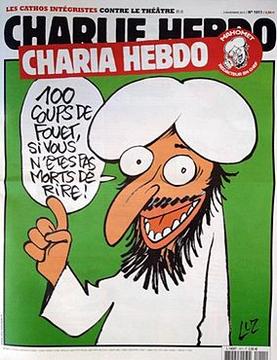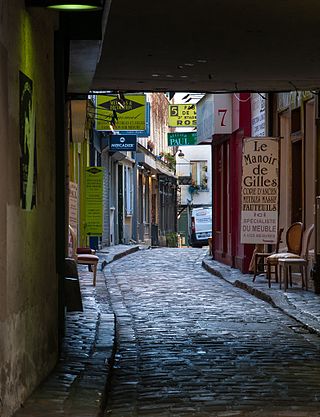 | |
| Location | Paris, France |
|---|---|
| From | Passage Sainte-Anne Popincourt |
| To | Rue Pelée |
The Rue Nicolas-Appert is a street in the 11th arrondissement of Paris, France.
 | |
| Location | Paris, France |
|---|---|
| From | Passage Sainte-Anne Popincourt |
| To | Rue Pelée |
The Rue Nicolas-Appert is a street in the 11th arrondissement of Paris, France.
The street is located in the Saint-Ambroise neighbourhood of the 11th arrondissement of Paris. [1] It starts at the Passage Sainte-Anne Popincourt and runs all the way to the Rue Pelée. [1] It is 137 metres (449 ft) long and 15 metres (49 ft) wide. [1]

It was constructed in 1985 [2] and named in honor of Nicolas Appert (1749-1841), a French businessman who invented airtight food preservation. [1]
The Comédie Bastille, a theatre, is located at no. 5. [3]
On 7 January 2015, the offices of the satirical weekly newspaper Charlie Hebdo at 10 rue Nicolas-Appert were attacked by Islamist terrorists. A commemorative plaque on the building records the names of eleven of the twelve people who were killed there. Charlie Hebdo has since moved. [4] In September 2020, there was a stabbing attack outside of the former headquarters of Charlie Hebdo.

The 4th arrondissement of Paris is one of the twenty arrondissements of the capital city of France. In spoken French, this arrondissement is referred to as quatrième. Along with the 1st, 2nd and 3rd arrondissements, it is in the first sector of Paris, which maintains a single local government rather than four separate ones.

The 11th arrondissement of Paris is one of the 20 arrondissements of the capital city of France. In spoken French, the arrondissement is referred to as le onzième.

The 20th arrondissement of Paris is the last of the consecutively numbered arrondissements of the capital city of France. Also known as Ménilmontant after the Ménilmontant neighbourhood it encompasses in its northwest, it is on the right bank of the River Seine and contains some of the city's most cosmopolitan districts. It covers four quarters: Belleville, Saint-Fargeau, Père-Lachaise and Charonne. In 2019, it had a population of 194,994.
Charlie Hebdo is a French satirical weekly magazine, featuring cartoons, reports, polemics, and jokes. The publication has been described as anti-racist, sceptical, secular, libertarian and within the tradition of left-wing radicalism, publishing articles about the far-right, religion, politics and culture.

The Rue de Richelieu is a long street of Paris, starting in the south of the 1st arrondissement at the Comédie-Française and ending in the north of the 2nd arrondissement. For the first half of the 19th century, before Georges-Eugène Haussmann redefined Paris with grand boulevards, it was one of the most fashionable streets of Paris.

The Charonne quarter is an area of the 20th arrondissement of Paris named after a former municipality in the area, which was merged into the city of Paris in 1860 by Napoleon III and split between Charonne quarter, the Père-Lachaise quarter and Saint-Fargeau quarter. The historic centre of Charonne is located around the junction of Rue de Bagnolet and Rue Saint-Blaise, in the vicinity of the parish church of Saint-Germain-de-Charonne.

The rue La Boétie is a street in the 8th arrondissement of Paris, running from rue d'Astorg to avenue des Champs-Élysées. It is named in honour of Étienne de La Boétie (1530–1563), friend of moralist Michel de Montaigne.

The Rue Molière is a short street in central Paris, in the 1st arrondissement. It begins at the Avenue de l'Opéra, near the Comédie-Française, and ends at the Rue de Richelieu with the Fontaine Molière.

The Porte Saint-Antoine was one of the gates of Paris. There were two gates named the Porte Saint-Antoine, both now demolished, of which the best known was that guarded by the Bastille, on the site now occupied by the start of the Rue de la Bastille in the 4th arrondissement of Paris.
This article presents the main landmarks in the city of Paris within administrative limits, divided by its 20 arrondissements. Landmarks located in the suburbs of Paris, outside of its administrative limits, while within the metropolitan area are not included in this article.

Nicolas Appert was a French confectioner and inventor who, in the early 19th century, invented airtight food preservation. Appert, known as the "father of food science", described his invention as a way "of conserving all kinds of food substances in containers".

On 7 January 2015, at about 11:30 a.m. in Paris, France, the employees of the French satirical weekly magazine Charlie Hebdo were targeted in a terrorist shooting attack by two French-born Algerian Muslim brothers, Saïd Kouachi and Chérif Kouachi. Armed with rifles and other weapons, the duo murdered 12 people and injured 11 others; they identified themselves as members of al-Qaeda in the Arabian Peninsula, which claimed responsibility for the attack. They fled after the shooting, triggering a manhunt, and were killed by the GIGN on 9 January. The Kouachi brothers' attack was followed by several related Islamist terrorist attacks across the Île-de-France between 7 and 9 January 2015, including the Hypercacher kosher supermarket siege, in which a French-born Malian Muslim took hostages and murdered four people before being killed by French commandos.

"Je suis Charlie" is a slogan and logo created by French art director Joachim Roncin and adopted by supporters of freedom of speech and freedom of the press after the 7 January 2015 shooting in which twelve people were killed at the offices of the French satirical weekly newspaper Charlie Hebdo. It identifies a speaker or supporter with those who were killed at the Charlie Hebdo shooting, and by extension, a supporter of freedom of speech and resistance to armed threats. Some journalists embraced the expression as a rallying cry for the freedom of self-expression.

Amedy Coulibaly, also known by the nom de guerre (kunya) Abu Basir al-Ifriqi was a Malian-French man who was the prime suspect in the Montrouge shooting, in which municipal police officer Clarissa Jean-Philippe was shot and killed, and was the hostage-taker and gunman in the Hypercacher Kosher Supermarket siege, in which he killed four hostages before being fatally shot by police.

Laurent "Riss" Sourisseau is a French cartoonist, author and publisher. Since 1992, he has worked for the French satirical weekly newspaper Charlie Hebdo and is now its majority owner.

The Republican marches were a series of rallies that took place in cities across France on 10–11 January 2015 to honour the victims of the Charlie Hebdo shooting, the Montrouge shooting and the Porte de Vincennes siege, as well as to voice support for freedom of speech and freedom of the press. French government officials estimated that the rallies were attended by up to 3.7 million people nationwide, making them the largest public rallies in French history. By their broad appeal, they were the first mass movement of their kind since 1944, when Paris was liberated from the Germans at the end of World War II.

The Boulevard Voltaire is a well-known boulevard in the 11th arrondissement of Paris. It was created by Baron Georges-Eugène Haussmann during the reign of French emperor Napoleon III. Originally named the Boulevard du Prince-Eugène, it was renamed the Boulevard Voltaire on 25 October 1870 in honour of the French Enlightenment writer, historian, and philosopher Voltaire.

From 7 to 9 January 2015, terrorist attacks occurred across the Île-de-France region, particularly in Paris. Three attackers killed a total of 17 people in four shooting attacks, and police then killed the three assailants. The attacks also wounded 22 other people. A fifth shooting attack did not result in any fatalities. Al-Qaeda in the Arabian Peninsula (AQAP) claimed responsibility and said that the coordinated attacks had been planned for years. The claim of responsibility for the deadly attack on the magazine came in a video showing AQAP commander Nasr Ibn Ali al-Ansi, with gunmen in the background that were later identified as the Kouachi brothers. However, while authorities say the video is authentic, there is no proof that AQAP helped to carry out the attacks. Amedy Coulibaly, who committed another leg of the attacks claimed that he belonged to ISIS before he died.

Charlie Hebdo issue No. 1011 is an issue of the French satirical newspaper Charlie Hebdo published on 2 November 2011. Several attacks against Charlie Hebdo, including an arson attack at its headquarters, were motivated by the issue's cover caricature of Muhammad, whose depiction is prohibited in some interpretations of Islam. The issue's subtitle Charia Hebdo references Islamic sharia law.

The Faubourg Saint-Antoine was one of the traditional suburbs of Paris, France. It grew up to the east of the Bastille around the abbey of Saint-Antoine-des-Champs, and ran along the Rue du Faubourg Saint-Antoine.
48°51′32″N2°22′13″E / 48.8590°N 2.3703°E